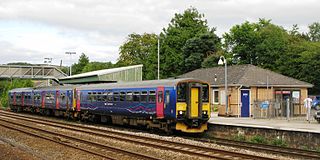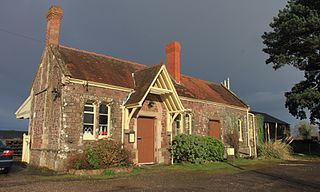
The West Somerset Railway (WSR) is a 22.75-mile (36.6 km) heritage railway line in Somerset, England. The freehold of the line and stations is owned by Somerset County Council; the railway is leased to and operated by West Somerset Railway plc ; which is supported and minority-owned by charitable trust the West Somerset Railway Association (WSRA) and the West Somerset Steam Railway Trust (WSSRT). The WSR plc operates services using both heritage steam and diesel trains.

Yeovil Junction railway station is the busier, but less central, of two railway stations serving the town of Yeovil in England. The station is 2 miles (3.2 km) outside the town, in the village of Stoford. Although Yeovil is in Somerset, the station was in Dorset until 1991. It is 122 miles 48 chains (197.3 km) down the line from London Waterloo.

West Somerset was a local government district in the English county of Somerset. The council covered a largely rural area, with a population of 34,900 in an area of 740 square kilometres (290 sq mi); it was the least populous non-unitary district in England. According to figures released by the Office for National Statistics in 2009, the population of West Somerset has the oldest average age in the United Kingdom at 52. The largest centres of population are the coastal towns of Minehead and Watchet (4,400).

Taunton railway station is a junction station on the route from London to Penzance, 143 miles (230 km) west of London Paddington station. It is situated in Taunton, Somerset, and is operated by Great Western Railway. It is also served by CrossCountry trains and by the West Somerset Railway on special event days and by mainline steam excursions.

Totnes railway station serves the towns of Totnes and Dartington in Devon, England. It was opened by the South Devon Railway Company in 1847. Situated on the Exeter to Plymouth Line, it is 28 miles 74 chains (46.6 km) down the line from Exeter St Davids and 222 miles 66 chains (358.6 km) measured from London Paddington via Bristol Temple Meads.

Highbridge and Burnham railway station is situated on the Bristol to Taunton Line within the town of Highbridge, Somerset, and also serves the neighbouring town of Burnham-on-Sea. It is 145 miles 25 chains (233.9 km) from London Paddington via Bristol Temple Meads. It is unstaffed but managed by Great Western Railway who operate all the regular services.

Weston-super-Mare railway station serves the seaside town of Weston-super-Mare in North Somerset, England. It is situated on a loop off the main Bristol to Taunton Line, 137 miles 33 chains (221.1 km) from London Paddington via Bristol Temple Meads.

The Bristol & Exeter Railway (B&ER) was an English railway company formed to connect Bristol and Exeter. It was built on the broad gauge and its engineer was Isambard Kingdom Brunel. It opened in stages between 1841 and 1844. It was allied with the Great Western Railway (GWR), which built its main line between London and Bristol, and in time formed part of a through route between London and Cornwall.

Minehead railway station is situated in Minehead in Somerset, England. First opened in 1874 as the terminus and headquarters of the Minehead Railway, it was closed by British Rail early in 1971. It reopened in 1976 and is now the terminus and headquarters of the West Somerset Railway, a heritage railway.

Dunster railway station is near Dunster, Somerset, England and is on the West Somerset Railway, a heritage railway.

Blue Anchor railway station is situated in the seaside village of Blue Anchor, Somerset, England and close to the larger village of Carhampton. It is on the West Somerset Railway, a heritage railway and houses the museum of the West Somerset Steam Railway Trust.

Washford railway station is a station on the West Somerset Railway, a heritage railway in England. The station is situated in the village of Washford, which is itself within the civil parish of Old Cleeve in the county of Somerset.

Watchet railway station is a station on the West Somerset Railway, a heritage railway in Somerset, England. It is situated in the small harbour town of Watchet.

Doniford Halt railway station, sometimes known as Doniford Beach Halt, is a request stop situated on the West Somerset Railway, a heritage railway in Somerset, England. It is situated by Helwell Bay on the outskirts of Watchet.

Stogumber railway station is a station in Kingswood, Somerset, England which serves the nearby village of Stogumber. It was opened by the West Somerset Railway in 1862 and closed by British Rail early in 1971. It was subsequently reopened in 1978 by the present day West Somerset Railway, a heritage line. It has a different layout to most stations, in that the main building lies on the opposite side of the tracks to the platform.

Crowcombe Heathfield railway station is a station on the West Somerset Railway, a heritage railway in Somerset, England. It is situated 2 miles (3.2 km) from the village of Crowcombe.

Bishops Lydeard railway station is a heritage railway station in the village of Bishops Lydeard, Somerset, England. It is the southern terminus for regular trains on the West Somerset Railway.

The Devon and Somerset Railway (D&SR) was a cross-country line that connected Barnstaple in Devon, England, to the network of the Bristol and Exeter Railway (B&ER) near Taunton. It was opened in stages between 1871 and 1873 and closed in 1966. It served a mostly rural area although it carried some through services from east of Taunton to the seaside resort of Ilfracombe.

Chard Central railway station was the principal railway station in Chard, Somerset, England. It was opened in 1866 and closed in 1962, during which time it was known by three different names.






















